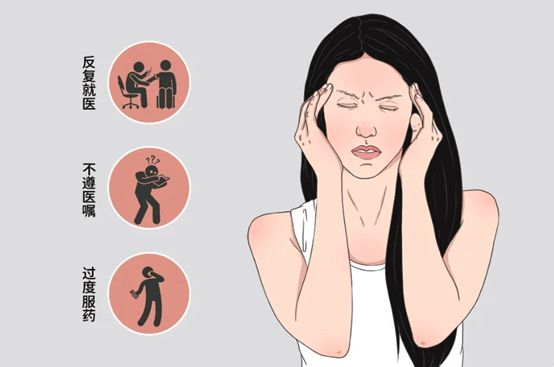Have you ever encountered people like this? They always feel a lot of physical discomfort, big or small, including headaches, dizziness, nausea, vomiting, etc., and the accompanying physical reactions make them extremely distressed. They repeatedly seek medical help at hospitals, but no specific issues are found upon examination. However, they do not believe it, and in the end, the doctor recommends visiting a psychiatrist.
In fact, they may have somatic symptom disorder. So what is somatic symptom disorder?
1. Symptoms of somatic symptom disorder
Pain symptoms are the most common symptoms of somatic symptom disorder, usually in various, widespread areas throughout the body such as limbs, chest, abdomen, head, and neck. The pain is generally not severe, and it may decrease or disappear when their mood improves.
Gastrointestinal symptoms include bloating, abdominal pain, constipation, diarrhea, belching, nausea, vomiting, etc.
Urogenital symptoms include frequent urination or difficulty urinating, as well as irregular menstruation, abnormal vaginal discharge, or sexual dysfunction.
Respiratory and circulatory symptoms include shortness of breath, inability to take deep breaths, chest tightness, discomfort in the precordial region, or palpitations.
Neurological symptoms include various limb weaknesses, numbness, as well as ataxia, blindness, deafness, and pseudo-neurological symptoms like skin numbness.
In addition, patients exhibit excessive worry and attention toward somatic symptoms, to the point where their lives revolve around seeking medical help.
2. Causes of somatic symptom disorder
1. Genetically, the exact cause of this disease is not yet fully understood.
2. Personality traits – Female patients are often associated with certain personality disorders, while male patients are often linked with anxiety.
3. Neurophysiology – Patients demonstrate functional impairments symmetrically in both frontal lobes of the brain. Dysfunction at the anterior part of the non-dominant hemisphere is more serious than in the posterior part.
4. Socio-psychiatric factors – Unhealthy habits may be the primary causative factor of this disorder, with life and work stress as well as emotional fluctuations serving as triggering factors.
3. Treatment of somatic symptom disorder
1. Establish a stable treatment alliance with a compassionate and accepting attitude towards the patient’s pain and complaints.
2. Inform the patient of the diagnosis and provide a positive explanation of somatic symptom disorder. Assure them that it is not a “mental illness” but a medical condition that does not lead to chronic mental or physical disabilities, let alone death.
3. Consistent assurance – Patients with somatic symptom disorder often worry that doctors have not conducted sufficient examinations, leading them to seek other doctors. Therefore, ensure the patient that the doctor has thoroughly evaluated the possibility of undisclosed physical illnesses, as frequent doctor changes only complicate matters further.
4. Therapists should establish a good relationship with the patient’s family to better understand the patient’s symptoms and promote changes in their unhealthy lifestyle.
5. Medication – Patients often have accompanying anxiety and depressive symptoms, low-dose antidepressants can improve their mood and alleviate symptoms. Low-dose anti-anxiety medications can also partially improve the symptoms of somatic symptom disorder patients. However, most patients may not experience significant therapeutic effects from these medications.


